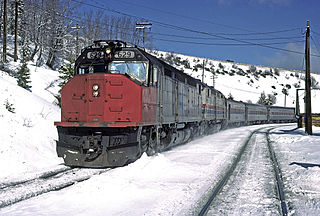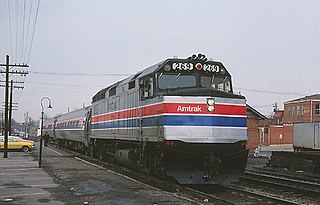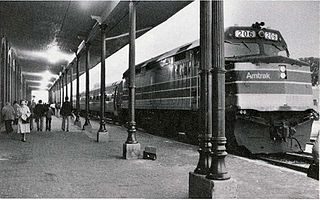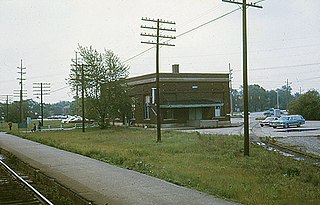Related Research Articles

The National Railroad Passenger Corporation, doing business as Amtrak, is the national passenger railroad company of the United States. It operates inter-city rail service in 46 of the 48 contiguous U.S. states and three Canadian provinces. Amtrak is a portmanteau of the words America and trak, the latter itself a sensational spelling of track.

The North Coast Hiawatha was a streamlined passenger train operated by Amtrak between Chicago, Illinois, and Seattle, Washington. Operating from 1971 to 1979, the train was a successor to the Northern Pacific Railway's North Coast Limited and Mainstreeter. Its name is a combination of North Coast Limited and Hiawatha, a Chicago, Milwaukee, St. Paul and Pacific Railroad train whose route it followed east of Minneapolis–St. Paul. Created at the behest of the United States Congress, the North Coast Hiawatha enjoyed an uncertain existence before being discontinued in 1979. Since then, there have been several unsuccessful attempts to restore it.

The Coast Daylight, originally known as the Daylight Limited, was a passenger train on the Southern Pacific Railroad (SP) between Los Angeles and San Francisco, California, via SP's Coast Line. It was advertised as the "most beautiful passenger train in the world," carrying a particular red, orange, and black color scheme. The train operated from 1937 until 1974, one of the few passenger trains retained by Amtrak in 1971. Amtrak merged it with the Coast Starlight in 1974.

The EMD SDP40F was a six-axle 3,000 hp (2.2 MW) C-C diesel–electric locomotive built by General Motors Electro-Motive Division (EMD) from 1973–1974. Based on Santa Fe's EMD FP45, EMD built 150 for Amtrak, the operator of most intercity passenger trains in the United States. Amtrak, a private company but funded by the United States government, had begun operation in 1971 with a fleet of aging diesel locomotives inherited from various private railroads. The SDP40F was the first diesel locomotive built new for Amtrak and for a brief time they formed the backbone of the company's long-distance fleet.

The International was a named passenger train operated between Chicago and Toronto. It was originally an overnight train operated by the Grand Trunk Railway of Canada and its successors the Canadian National Railway and Grand Trunk Western Railroad, running as far as Montreal. The train was cut back to Port Huron, Michigan, in 1970 and discontinued in 1971.

Hammond–Whiting station is an Amtrak intercity train station in Hammond, Indiana. The station is along the former Pennsylvania Railroad Fort Wayne Line, now owned by Norfolk Southern Railway. North of the station lies the former Baltimore and Ohio and Elgin, Joliet and Eastern Railroad tracks. The station building and parking lot lies on the former New York Central Railroad mainline. Hammond–Whiting opened on September 11, 1982. Until the early 2000s, it was served by all Amtrak service that ran east from Chicago; today, it is only served by two daily Wolverine round trips.

Roseville station is an Amtrak train station in Roseville, California, United States, served by the California Zephyr and Capitol Corridor

The West Virginian, later known as the Potomac Turbo and Potomac Special, was a daily passenger train operated by Amtrak between Washington, D.C., and Parkersburg, West Virginia. This route was previously served by the Baltimore & Ohio's (B&O) train of the same name, and was the first of several services in the state of West Virginia established at the behest of US Representative Harley Orrin Staggers, the powerful chair of the House Interstate and Foreign Commerce Committee. This patronage earned the train the derisive sobriquets "Harley's Hornet" and the "Staggers Special".

The James Whitcomb Riley was a passenger train that operated between Chicago, Illinois, and Cincinnati, Ohio, via Indianapolis, Indiana. Originally operated by the New York Central Railroad, it was taken over by Amtrak in 1971. Under Amtrak, it merged with the Chesapeake & Ohio Railway's George Washington to become a Chicago-Washington/Newport News train. In 1977, it was renamed the Cardinal, which remains in operation.

The Shenandoah was a daily passenger train operated by Amtrak between Washington and Cincinnati from 1976 until 1981.

The Blue Ridge was a daily Amtrak passenger train that operated between Washington, D.C., and Cumberland, Maryland. Service began in 1973; it was merged into the MARC Brunswick Line commuter rail service in 1986.

The Michigan Executive was a commuter train operated by Amtrak between Detroit, Michigan, and Jackson, Michigan. Amtrak took over the service from Penn Central in 1975 and discontinued it in 1984.

The Pacific International was a passenger train operated by Amtrak between Seattle, Washington and Vancouver, British Columbia. It was Amtrak's first international train service, operating from 1972 until 1981.

The New England States was a passenger train operated by the New York Central Railroad and its successor Penn Central over the Water Level Route between Chicago and Boston. It was launched in 1938, in tandem with the relaunch of the newly-streamlined 20th Century Limited, and assumed responsibility for that train's Boston sleepers. In 1949 it became the first Chicago–Boston streamliner. The New York Central dropped the name in 1967; an unnamed remnant continued running until 1971. Amtrak's Lake Shore Limited now serves the route.

The National Limited was a passenger train that ran between Kansas City, Missouri, and both New York City and Washington, D.C., splitting in Pennsylvania. Amtrak operated the train from 1971 to 1979.
The Twilight Limited was a named passenger train in the United States which initially operated between Chicago, Illinois, and Detroit, Michigan. The New York Central Railroad introduced the train in 1926, and it continued until the formation of Amtrak in 1971, although it lost its name in 1967. Amtrak renamed the train St. Clair, feeling that the name "Twilight Limited" had undesirable connotations and imagery for a company trying to save passenger rail service. Amtrak revived the name in 1976 for a new train frequency on the Chicago–Detroit corridor, and kept the name until all trains on that corridor were renamed Wolverine in 2004.

The Hi-Level was a type of bilevel intercity railroad passenger car used in the United States. Car types included coaches, dining cars, and lounge cars; a sleeping car variant was considered but never produced. Most passenger spaces were on the upper level, which featured a row of windows on both sides. Boarding was on the lower level; passengers climbed up a center stairwell to reach the upper level. Vestibules on the upper level permitted passengers to walk between cars; some coaches had an additional stairwell at one end to allow access to single-level equipment.

SEMTA Commuter Rail, also known as the Silver Streak, was a commuter train operated by the Southeastern Michigan Transportation Authority (SEMTA) and the Grand Trunk Western Railroad between Detroit and Pontiac, Michigan. It began in 1974 when SEMTA assumed control of the Grand Trunk's existing commuter trains over the route. SEMTA discontinued operations in 1983. Amtrak began offering intercity service between Detroit and Pontiac in 1994 as part of its Michigan Services.

Gary station was a railway station in Gary, Indiana. It was located at 5th and Chase Streets, initially serving the Pennsylvania Railroad.
References
- Cox, Jim (2011). Rails Across Dixie: A History of Passenger Trains in the American South. Jefferson, NC: McFarland. ISBN 9780786445288. OCLC 609716000.
- Hilton, George W. (1980). Amtrak: The National Railroad Passenger Corporation (PDF). Washington, DC: American Enterprise Institute for Public Policy Research. ISBN 0-8447-3369-5. OCLC 5777023.
- Sanders, Craig (2006). Amtrak in the Heartland. Bloomington, Indiana: Indiana University Press. ISBN 978-0-253-34705-3.
- Solomon, Brian (2004). Amtrak. Saint Paul, Minnesota: MBI. ISBN 978-0-7603-1765-5.
- Thoms, William E. (1973). Reprieve for the Iron Horse: The AMTRAK Experiment–Its Predecessors and Prospects. Baton Rouge, LA: Claitor's Publishing Division. OCLC 1094744.